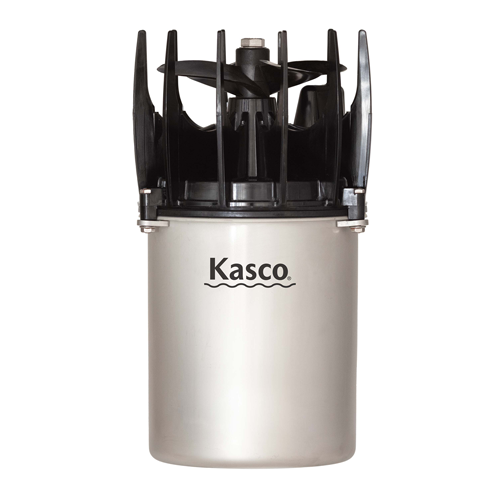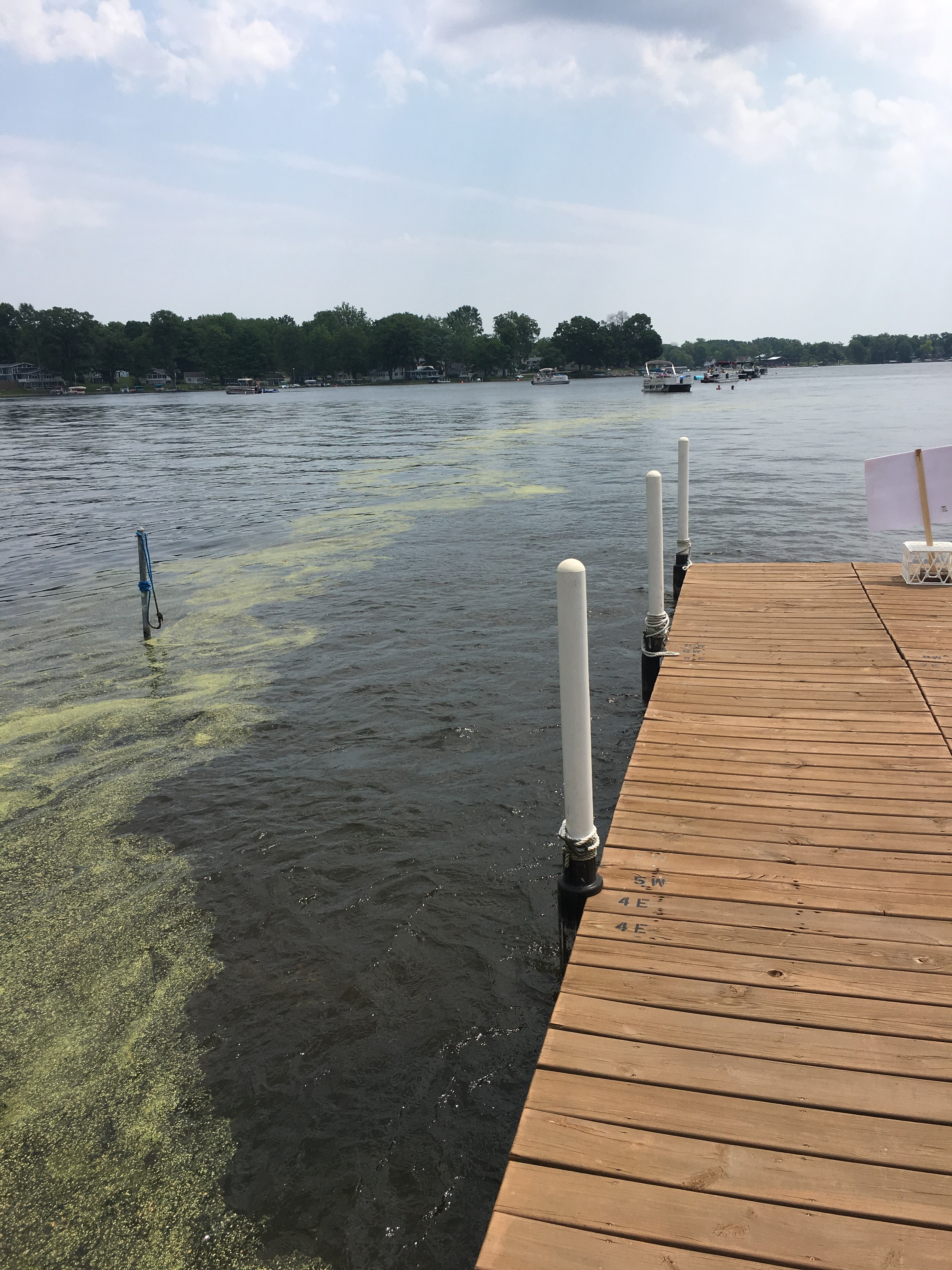Webster Lake Conservation Association
Weed Treatment


Water Circulator Pump
and Weeds
Herbicidal Weed Treatments are essential in keeping Webster Lake navigable and enjoyable for all recreational purposes. All weed treatments are funded by dues and extra contributions to the Invasive Weed Treatment Fund made by Webster and Backwater Lake property owners and other friends of the Webster Lake Conservation Association. The only other funding to this effort comes from a grant program administered by the Indiana Department of Natural Resources (INDR) through the Lakes and Rivers Enhancement Program (LARE). WLCA volunteer board members apply for such a grant annually. If awarded, the grant applies to a portion of the cost for the treatment of invasive weeds only. All shoreline and channel weed treatments for nuisance native and invasive weeds are paid by WLCA members as noted above.
WLCA employs a licensed, independent herbicide contractor to provide spring and fall surveys of aquatic weed growth and weed mass locations within the lake. The contractor participates with WLCA in discussions with IDNR in the creation of an annual vegetation management plan as required and regulated by IDNR.
WLCA has taken aggressive action attempting to eradicate Eurasian Watermilfoil, Curly Leaf Pondweed, and Starry Stonewort, invasive vegetation and algae that have also troubled many other Indiana lakes. Please see the recently updated Weed Treatment Plan and historical treatment plans posted below along with information about Water Circulators and the extent to which lake front property owners may amend their frontage without the need to file for a permit.
Water Circulator Info, Brochure, and Order Forms
Consider this mechanical means to help dissipate Duckweed and Weed Chop at your shoreline. Please contact WLCA via this website with any additional questions. Note: This device will not eliminate the need to physically remove larger/thicker weed masses from your waterfront, but it will help in your efforts.
Permit Exempt Aquatic Weed Control by Property Owners/Tenants - The 625 sq. ft. Rule Explained
The Indiana Department of Natural Resources has recently created an infographic brochure to explain the extent of treatment and rules under which an owner or tenant of land adjacent to public waters can, themselves, control aquatic vegetation along their own shoreline frontage. It is important to note that ALL conditions indicated in the brochure must be met in order to be exempt from the permitting process otherwise required by the IDNR. Failure to meet ALL itemized conditions will put the owner/tenant at risk of prosecution.
Webster Lake residents should consider that the WLCA annually secures a permit for third-party herbicide treatment of more than 60 acres of channels and shorelines on Webster Lake. Therefore, owners and tenants may wish to delay any consideration of additional shoreline vegetation self-treatment until approximately 2 weeks after the WLCA's shoreline and channel treatments have been applied. Treatment results are generally visible within 2 weeks. Advance notice of WLCA-sponsored shoreline and channel treatments is made available to owners/tenants who have provided their e-mail addresses to WLCA via the Contact Us page on this website. Informational bulletins are sent via a secure group e-mail service (Mailchimp). Yellow warning notices are posted on property shorelines by the herbicide contractor on the day of treatment.
2025 Treatment Plan Updates
- May 3, 2025 Bulletin – May 8 Additional Channel Treatments and Map (PDF)
- April 29, 2025 Bulletin – Early Spring CLP Weed Treatment, Dates and Map (PDF)
January 2024: Updated 2024 Annual Vegetation Management Plan including recommendations for 2025 treatments. This report was prepared for WLCA by Aquatic Weed Control, Inc. as required by the IDNR, which allowed WLCA to apply for a grant through the Lakes and River Enhancement (LARE) grant program. The LARE Grant will cover 80% of the cost for preparation and review of a required 2025 Annual Vegetation Management Plan up to $4,400 and 80% of the cost to treat up to 84.5 acres of Eurasian Water Milfoil (EWM) and 5 acres of Starry Stonewort ($2,000), not to exceed the total potential grant of $34,400. WLCA is reponsible for the remaining 20% of the invasive weed treatment cost for EWM and Starry Stonewort (to be paid by membership dues). In 2025 IDNR is permitting WLCA to treat up to 77.5 acres of invasive Curly Leaf Pondweed (CLP) and up to 69 acres of nuisance native weeds located in channels (12 acres) or within 50 feet of shorelines (56.6 acres); however, the LARE grant will not cover the cost of these treatments. WLCA must pay 100% of the treatment cost not covered by the LARE grant. WLCA member dues payments and extra contributions to the Weed Fund are used to cover the cost of these herbicide treatments. Herbicide treatments of weeds in the greater lake and at shorelines and channels are essential to the improvement of lake navigation and in minimizing weed-chop caused by boats driving through weed beds.
2024 Treatment Plan Updates
- June 7, 2024 Bulletin – June 11 Shoreline Herbicide Treatment & Water Use Restrictions (PDF)
- May 31, 2024 Bulletin – June 4 Weed Treatment for Shorelines and Channels (PDF)
- May 18, 2024 Bulletin - May 20 Weed Treatment for Eurasian Water Milfoil (PDF)
- April 22, 2024 Bulletin – April 24–26 Weed Treatment for Invasive Curly Leaf Pondweed (PDF)
January 2024: Updated 2023 Annual Vegetation Management Plan including recommendations for 2024 treatments. This report was prepared for the WLCA by Solitude Lake Services as required by the IDNR for the WLCA to participate in the Lakes and River Enhancement (LARE) grant program. Updates and treatments for 2024 were completed by Aquatic Weed Control, Inc, Syracuse, IN.
2023 Treatment Plan Updates
- May 23, 2023 bulletin – Weed Treatment for Invasives - Shoreline, Channels (PDF)
- May 9, 2023 bulletin – Weed Treatment of Invasive Curly Leaf Pondweed (PDF)
January 2023: Updated 2022 Annual Vegetation Management Plan including recommendations for 2023 treatments. This report was prepared for the WLCA by Clarke Aquatic Services, Inc. and updated by Solitude Lake Management. The report is required by the IDNR for the WLCA to participate in the Lakes and River Enhancement (LARE) Grant Program. Clarke Aquatic Services was acquired by Solitude Lake Management. The 2023 herbicide treatments were applied by Solitude Lake Management.
2022 Treatment Plan Updates
- May 19, 2022 bulletin – May 23–26 LARE Treatment-Invasive CLP + WLCA shoreline-channel (PDF)
- May 4, 2022 bulletin – Weed Treatment of Invasive Curlyleaf Pond Weed (PDF)
January 2022: Updated 2021 Annual Vegetation Management Plan including recommendations for 2022 treatments. This report was prepared for the WLCA by Clarke Aquatic Services, Inc. as required by the IDNR in order for the WLCA to participate in the Lakes and River Enhancement (LARE) grant program.
2021 Treatment Plan Updates
- June 14, 2021 bulletin – Dixie Ride, Weed Treatment Details, Circulators, & Safety (PDF)
- May 26, 2021 bulletin – Weed Treatment Date Change (PDF)
- May 17, 2021 bulletin – WLCA Planned Weed Treatments (May & June) (PDF)
- May 10, 2021 bulletin – GPS Weed Location Survey and Future Weed Treatments (PDF)
- May 5, 2021 bulletin – Limited Shoreline Weed Treatment on May 6, 2021 (PDF)
January 2021: Updated 2020 Annual Vegetation Management Plan including recommendations for 2021 treatments. Maps of treatment areas are included. This report was prepared for the WLCA by Clarke Aquatic Services, Inc. as required by the IDNR in order for the WLCA to participate in the Lakes and River Enhancement (LARE) grant program.
2020 Treatment Plan Updates
- June 2, 2020 bulletin on Webster Lake shoreline & channel weed treatment (PDF)
- May 27, 2020 bulletin on lake conditions & changes to weed treatment plan (PDF)
- May 20, 2020 bulletin on event cancellations & initial weed treatment plan (PDF)
January 2020: Updated 2019 Annual Vegetation Management Plan including recommendations for 2020 treatments. Maps of treatment areas are included. This report was prepared for the WLCA by Clarke Aquatic Services, Inc. as required by the IDNR in order for WLCA to participate in the Lakes and River Enhancement (LARE) grant program.
January 2019: Updated 2018 Annual Vegetation Management Plan including recommendations for 2019 treatments. Maps of treatment areas are included. This report was prepared for the WLCA by Clarke Aquatic Services, Inc. as required by the IDNR in order for WLCA to participate in the Lakes and River Enhancement (LARE) grant program.
August 2018: 2018 Weed Maps - Spring, Summer, and Fall Maps of the weed volume in Webster Lake. The Summer and Fall maps (Maps 2 and 3) reflect a progressive reduction of the weed volume attributable to the herbicide treatments.
June 2018: Mechanical Water Circulator 2-page Flyer and Price List for Webster Lake Property Owners; distributed to select Webster Lake property owners via U.S. Mail and posted to the Website June 2018.
October 2017: Year-End Weed Report and Funding Request; distributed to Webster Lake residents in October 2017 via e-mail or U.S. regular mail.
September 11, 2017: Here is a slide-show presentation prepared by Aquatic Control for the WLCA September 11 Board of Directors meeting. Please note the color-coded map of Webster Lake prepared from data collected in 2015. This data influenced the decisions made in 2016 relative to weed treatment permits and LARE grants. Data collected in 2017 has been submitted to the IDNR for their consideration regarding treatment of Webster Lake in 2018.
August 2017: Volunteer WLCA officers and directors spent approximately three days during August 2017 mapping the lake with a Lowrance sonar unit in preparation of an annually required IDNR aquatic vegetation report. See Entry at May 2017 below for a more detailed description.
June 22, 2017: A non-selective weed and algae treatment of the shoreline and channels of Webster Lake was completed by our weed management contractor at a cost of $24,604.
May 10, 2017: A selective treatment was applied to the remaining 60 acres (down from 155 acres the prior year) of the invasive weed Eurasian watermilfoil throughout Webster Lake. 80% of the treatment for watermilfoil was reimbursed by a LARE Grant, leaving WLCA a balance due of $2,884. Also, the shoreline and channels in the Miller's Landing area of Webster Lake received a special treatment for invasive curly-leaf pondweed that was growing in abundance. The curly-leaf treatment was paid in full by the WLCA at $4,800.
May 2017: Volunteer WLCA officers and directors spent approximately three days during May 2017 mapping the lake with a Lowrance sonar unit in preparation of an annually required IDNR aquatic vegetation report. The initial cost of the Lowrance unit was $1,700, including mounting brackets. Annually, WLCA pays a licensing fee of approximately $900 which allows the uploading of the data collected and the creation of a map showing the location, growth, and volume of vegetation in the Lake. Previously, the mapping was done by an outside contractor at an annual cost that exceeded the purchase price of the equipment and licensing fee.
September 13, 2016: Here is a slide-show presentation prepared by Aquatic Control for the LARE Grant Public Hearing held 09-08-2016. Please note the color-coded map of Webster Lake prepared from data collected in 2015. This data influenced the decisions made in 2016 relative to weed treatment permits and LARE grants.
June 10, 2016: The Mail-Journal, June 1, 2016. DNR allowing more weed control at Lake Webster.